catalogue
1, Introduction
Sites separated from the front end and the back end generally use jwt or identity server 4 to generate token s for login authentication. What we want to say here is the correct way of site login authorization when the front and back ends of small projects are not separated.
2, Traditional authorization method
Let's talk about the traditional authorization method, which is completed by session or cookies.
1. Before requesting an Action, verify whether the current operator has logged in and has permission
2. If you don't have permission, jump to the login page
3. AOP filter for traditional login authorization: ActionFilter.
The specific implementation is as follows:
1. Add a class CurrentUser.cs to save user login information
/// <summary>
///Login user information
/// </summary>
public class CurrentUser
{
/// <summary>
///User Id
/// </summary>
public int Id { get; set; }
/// <summary>
///User name
/// </summary>
public string Name { get; set; }
/// <summary>
///Account number
/// </summary>
public string Account { get; set; }
}
2. Create a cookie / session help class, CookieSessionHelper.cs
public static class CookieSessionHelper
{
public static void SetCookies(this HttpContext httpContext, string key, string value, int minutes = 30)
{
httpContext.Response.Cookies.Append(key, value, new CookieOptions
{
Expires = DateTime.Now.AddMinutes(minutes)
});
}
public static void DeleteCookies(this HttpContext httpContext, string key)
{
httpContext.Response.Cookies.Delete(key);
}
public static string GetCookiesValue(this HttpContext httpContext, string key)
{
httpContext.Request.Cookies.TryGetValue(key, out string value);
return value;
}
public static CurrentUser GetCurrentUserByCookie(this HttpContext httpContext)
{
httpContext.Request.Cookies.TryGetValue("CurrentUser", out string sUser);
if (sUser == null)
{
return null;
}
else
{
CurrentUser currentUser = Newtonsoft.Json.JsonConvert.DeserializeObject<CurrentUser>(sUser);
return currentUser;
}
}
public static CurrentUser GetCurrentUserBySession(this HttpContext context)
{
string sUser = context.Session.GetString("CurrentUser");
if (sUser == null)
{
return null;
}
else
{
CurrentUser currentUser = Newtonsoft.Json.JsonConvert.DeserializeObject<CurrentUser>(sUser);
return currentUser;
}
}
}
3. Create a login controller AccountController.cs
public class AccountController : Controller
{
//Login page
public IActionResult Login()
{
return View();
}
//Login submission
[HttpPost]
public IActionResult LoginSub(IFormCollection fromData)
{
string userName = fromData["userName"].ToString();
string passWord = fromData["password"].ToString();
//The real writing method is read database verification
if (userName == "test" && passWord == "123456")
{
#region traditional session/cookies
//Login succeeded, and the user login information is recorded
CurrentUser currentUser = new CurrentUser()
{
Id = 123,
Name = "Test account",
Account = userName
};
//Write sessin
// HttpContext.Session.SetString("CurrentUser", JsonConvert.SerializeObject(currentUser));
//Write cookies
HttpContext.SetCookies("CurrentUser", JsonConvert.SerializeObject(currentUser));
#endregion
//Jump to home page
return RedirectToAction("Index", "Home");
}
else
{
TempData["err"] = "Incorrect account or password";
//The account and password are incorrect. Jump back to the login page
return RedirectToAction("Login", "Account");
}
}
/// <summary>
///Log out
/// </summary>
/// <returns></returns>
public IActionResult LogOut()
{
HttpContext.DeleteCookies("CurrentUser");
//Session mode
// HttpContext.Session.Remove("CurrentUser");
return RedirectToAction("Login", "Account");
}
}
4. Login.cshtml content of login page
<form action="/Account/LoginSub" method="post">
<div>
account number:<input type="text" name="userName" />
</div>
<div>
account number:<input type="password" name="passWord" />
</div>
<div>
<input type="submit" value="Sign in" /> <span style="color:#ff0000">@TempData["err"]</span>
</div>
</form>
5. Create a login and successfully jump to HomeController.cs
public class HomeController : Controller
{
public IActionResult Index()
{
//Get user information from cookie
CurrentUser user = HttpContext.GetCurrentUserByCookie();
//CurrentUser user = HttpContext.GetCurrentUserBySession();
return View(user);
}
}
6. Page Index.cshtml
@{
ViewData["Title"] = "Index";
}
@model SessionAuthorized.Demo.Models.CurrentUser
<h1>welcome @Model.Name Come to the home page</h1>
<div><a href="/Account/Logout">Log out</a></div>
7. Add the authentication filter MyActionAuthrizaFilterAttribute.cs, implement IActinFilter, and write the authentication logic in OnActionExecuting
public class MyActionAuthrizaFilterAttribute : Attribute, IActionFilter
{
public void OnActionExecuted(ActionExecutedContext context)
{
//throw new NotImplementedException();
}
/// <summary>
///Before entering action
/// </summary>
/// <param name="context"></param>
public void OnActionExecuting(ActionExecutingContext context)
{
//throw new NotImplementedException();
Console.WriteLine("Start verifying permissions...");
// CurrentUser currentUser = context.HttpContext.GetCurrentUserBySession();
CurrentUser currentUser = context.HttpContext.GetCurrentUserByCookie();
if (currentUser == null)
{
Console.WriteLine("No permission...");
if (this.IsAjaxRequest(context.HttpContext.Request))
{
context.Result = new JsonResult(new
{
Success = false,
Message = "No permission"
});
}
context.Result = new RedirectResult("/Account/Login");
return;
}
Console.WriteLine("Permission verification succeeded...");
}
private bool IsAjaxRequest(HttpRequest request)
{
string header = request.Headers["X-Requested-With"];
return "XMLHttpRequest".Equals(header);
}
}
Add this Filter to the controller or method that needs authentication to complete authentication. Here, add authentication in the home page, and users who log in successfully can access it
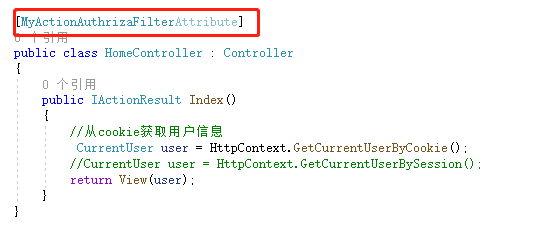
8. If you want to use Session, you should also add Session in startup.cs
public void ConfigureServices(IServiceCollection services)
{
services.AddControllersWithViews();
services.AddSession();
}
public void Configure(IApplicationBuilder app, IWebHostEnvironment env)
{
if (env.IsDevelopment())
{
app.UseDeveloperExceptionPage();
}
else
{
app.UseExceptionHandler("/Error");
// The default HSTS value is 30 days. You may want to change this for production scenarios, see https://aka.ms/aspnetcore-hsts.
app.UseHsts();
}
app.UseHttpsRedirection();
app.UseStaticFiles();
app.UseSession();
app.UseRouting();
app.UseAuthorization();
app.UseEndpoints(endpoints =>
{
endpoints.MapDefaultControllerRoute();
});
}
Here, the traditional authentication is completed. Let's verify the effect.
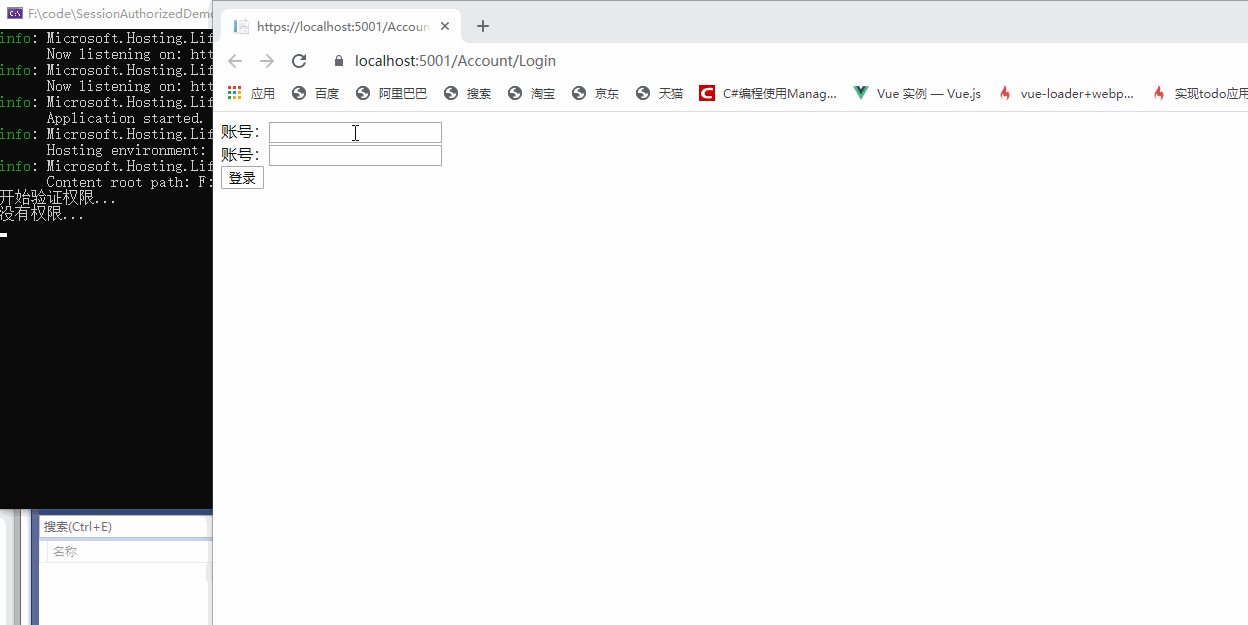
3, Correct authentication method in. NET5
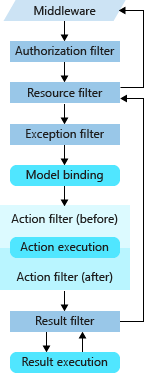
The traditional authorization method is completed through the Action Filter(before). It can be found from the filter sequence of the. Net Core in the figure above that there are many filters before the Action filter(befre). If the authentication can be done before, it will save a few steps. Therefore, the correct authentication should be done in the authorization filter, Authorization filter is specially used for authentication and authorization in. NET5.
How? Authentication and authorization are supported through middleware.
1. app.UseRouting() in the Configure method of setup. CS; Then, add authentication authorization before app.UseEndpoints();
public void Configure(IApplicationBuilder app, IWebHostEnvironment env)
{
if (env.IsDevelopment())
{
app.UseDeveloperExceptionPage();
}
else
{
app.UseExceptionHandler("/Error");
// The default HSTS value is 30 days. You may want to change this for production scenarios, see https://aka.ms/aspnetcore-hsts.
app.UseHsts();
}
app.UseHttpsRedirection();
app.UseStaticFiles();
app.UseSession();
app.UseRouting();
app.UseAuthentication();//Detect whether the user is logged in
app.UseAuthorization(); //Authorization, check whether you have permission and whether you can access functions
app.UseEndpoints(endpoints =>
{
endpoints.MapDefaultControllerRoute();
});
}
2. Add in ConfigureServices
public void ConfigureServices(IServiceCollection services)
{
services.AddControllersWithViews();
//services.AddSession(); Traditional authentication
services.AddAuthentication(CookieAuthenticationDefaults.AuthenticationScheme)
.AddCookie(options => {
options.LoginPath = new PathString("/Account/Login");//No login, jump to this path
});
}
3. Mark which controllers or methods require login authentication. Mark the [Authorize] feature in the controller or method header. If there are methods that do not require login authentication, add an anonymous access ID [AllowAnonymousAttribute]
// [myactionauthorizafilterattribute] traditional authorization
[Authorize]
public class HomeController : Controller
{
public IActionResult Index()
{
//Get user information from cookie
// CurrentUser user = HttpContext.GetCurrentUserByCookie();
//CurrentUser user = HttpContext.GetCurrentUserBySession();
var userInfo = HttpContext.User;
CurrentUser user = new CurrentUser()
{
Id = Convert.ToInt32(userInfo.FindFirst("id").Value),
Name = userInfo.Identity.Name,
Account=userInfo.FindFirst("account").Value
};
return View(user);
}
/// <summary>
///Anonymous access without login
/// </summary>
/// <returns></returns>
[AllowAnonymousAttribute]
public IActionResult About()
{
return Content("Welcome to the about page");
}
}
4. Code of AccountController.cs at login
public class AccountController : Controller
{
//Login page
public IActionResult Login()
{
return View();
}
//Login submission
[HttpPost]
public IActionResult LoginSub(IFormCollection fromData)
{
string userName = fromData["userName"].ToString();
string passWord = fromData["password"].ToString();
//The real writing method is read database verification
if (userName == "test" && passWord == "123456")
{
#region traditional session/cookies
//Login succeeded, and the user login information is recorded
//CurrentUser currentUser = new CurrentUser()
//{
// Id = 123,
// Name = "test account",
// Account = userName
//};
//Write sessin
// HttpContext.Session.SetString("CurrentUser", JsonConvert.SerializeObject(currentUser));
//Write cookies
//HttpContext.SetCookies("CurrentUser", JsonConvert.SerializeObject(currentUser));
#endregion
//User role list. The actual operation is to read the database
var roleList = new List<string>()
{
"Admin",
"Test"
};
var claims = new List<Claim>() //Save user information with Claim
{
new Claim(ClaimTypes.Name,"Test account"),
new Claim("id","1"),
new Claim("account",userName),//... any information can be added
};
//Fill role
foreach(var role in roleList)
{
claims.Add(new Claim(ClaimTypes.Role, role));
}
//Load user information into ClaimsPrincipal
ClaimsPrincipal claimsPrincipal = new ClaimsPrincipal(new ClaimsIdentity(claims, "Customer"));
//Log in and write user information to the cookie
HttpContext.SignInAsync(CookieAuthenticationDefaults.AuthenticationScheme, claimsPrincipal,
new AuthenticationProperties
{
ExpiresUtc = DateTime.Now.AddMinutes(30)//Expiration time 30 minutes
}).Wait();
//Jump to home page
return RedirectToAction("Index", "Home");
}
else
{
TempData["err"] = "Incorrect account or password";
//The account and password are incorrect. Jump back to the login page
return RedirectToAction("Login", "Account");
}
}
/// <summary>
///Log out
/// </summary>
/// <returns></returns>
public IActionResult LogOut()
{
// HttpContext.DeleteCookies("CurrentUser");
//Session mode
// HttpContext.Session.Remove("CurrentUser");
HttpContext.SignOutAsync(CookieAuthenticationDefaults.AuthenticationScheme);
return RedirectToAction("Login", "Account");
}
}
5. Verification results:
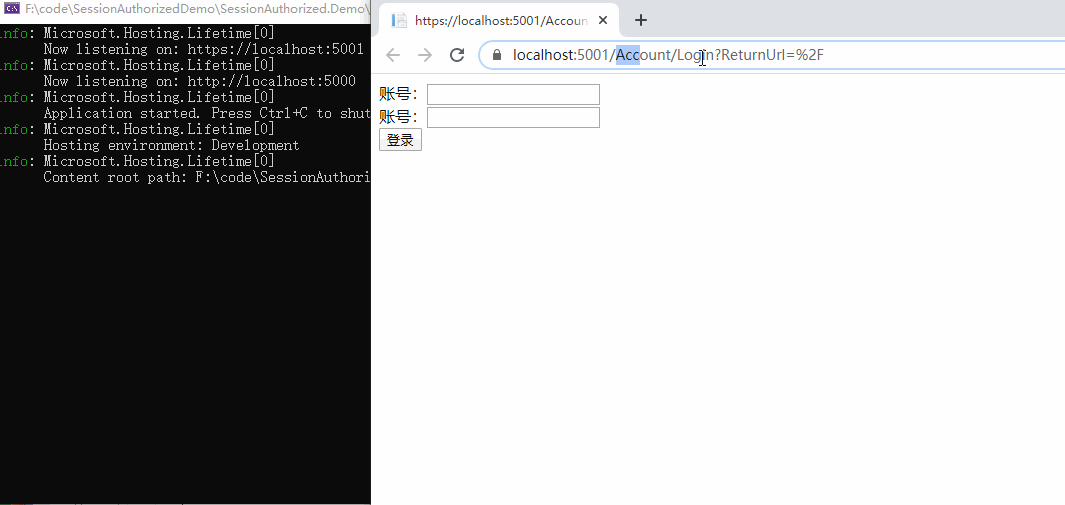
It can be seen that if there is no login status at the beginning, accessing / Home/Index will jump to the login page. If you visit / Home/About successfully, it proves that the anonymous access is ok,
In the later login, the user information is displayed. There is no problem exiting the login. There is no problem with the certification function. Authentication is completed here.
This built-in login authentication is interpreted as user information using cookie s, so it is OK to balance the load of multiple servers on the site (I have verified that it is OK under nginx load).
4, Role authorization in. Net 5
The user role has been recorded in the above claims. This role can be used for authorization.
In startup.cs, modify the path to jump to the page without permission
public void ConfigureServices(IServiceCollection services)
{
services.AddControllersWithViews();
//services.AddSession(); Traditional authentication
services.AddAuthentication(CookieAuthenticationDefaults.AuthenticationScheme)
.AddCookie(options => {
options.LoginPath = new PathString("/Account/Login");//No login, jump to this path
options.AccessDeniedPath = new PathString("/Account/AccessDenied");//You don't have permission to jump to this path
});
}
AccountController.cs adding method
public IActionResult AccessDenied()
{
return View();
}
View content
No access-401
1. Single role access
Add a property to the method header [Authorize(Roles = "role code")]
Add a method in HomeController.cs
/// <summary>
///Role Admin can access
/// </summary>
/// <returns></returns>
[Authorize(Roles ="Admin")]
public IActionResult roleData1() {
return Content("Admin Can access");
}
verification.
Start role is
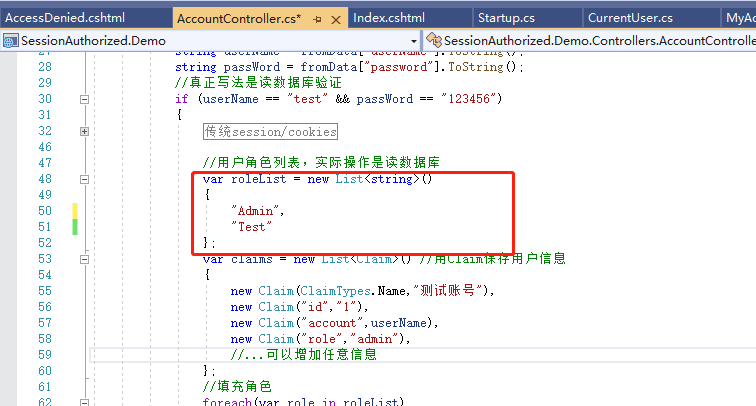
To access roleData1 data:

After successful access, remove the role Admin
var roleList = new List<string>()
{
//"Admin",
"Test"
};
Log in again to access rleData1 data:

If the access is unsuccessful, you will jump to the preset page without permission.
2. "Multiple roles contain one" permission
[Authorize(Roles = "Admin,Test")]//Multiple roles are separated by commas. If a role contains one, it can be accessed
public IActionResult roleData2()
{
return Content("roleData2 Access successful");
}
3. "Multiple role combination" permission
/// <summary>
///All roles that have tags at the same time can be accessed
/// </summary>
/// <returns></returns>
[Authorize(Roles = "Admin")]
[Authorize(Roles = "Test")]
public IActionResult roleData3()
{
return Content("roleData3 Access successful");
}
5, Custom policy authorization
What are the disadvantages of the above role authorization? The biggest disadvantage is that the role must be written to the method in advance. If you want to modify it, you can only change the code, which is obviously troublesome. The permissions in the actual project are modified according to the configuration,
Therefore, you need to use custom policy authorization.
Step 1:
Add a customauthorizationrequirement.cs to implement the interface: IAuthorizationRequirement
/// <summary>
///Policy authorization parameters
/// </summary>
public class CustomAuthorizationRequirement: IAuthorizationRequirement
{
/// <summary>
///
/// </summary>
public CustomAuthorizationRequirement(string policyname)
{
this.Name = policyname;
}
public string Name { get; set; }
}
Add CustomAuthorizationHandler.cs ------ dedicated to checking logic; It is required to inherit from the authorizationhandler < > generic abstract class;
/// <summary>
///Custom authorization policy
/// </summary>
public class CustomAuthorizationHandler: AuthorizationHandler<CustomAuthorizationRequirement>
{
public CustomAuthorizationHandler()
{
}
protected override Task HandleRequirementAsync(AuthorizationHandlerContext context, CustomAuthorizationRequirement requirement)
{
bool flag = false;
if (requirement.Name == "Policy01")
{
Console.WriteLine("Enter custom policy authorization 01...");
///Logic of strategy 1
}
if (requirement.Name == "Policy02")
{
Console.WriteLine("Enter custom policy authorization 02...");
///Logic of strategy 2
}
if(flag)
{
context.Succeed(requirement); //Verification passed
}
return Task.CompletedTask; //Verified different
}
}
The second step is to make the custom logic take effect.
Register in the ConfigureServices method of starup.cs
public void ConfigureServices(IServiceCollection services)
{
services.AddControllersWithViews();
//services.AddSession(); Traditional authentication
services.AddSingleton<IAuthorizationHandler, CustomAuthorizationHandler>();
services.AddAuthentication(CookieAuthenticationDefaults.AuthenticationScheme)
.AddCookie(options =>
{
options.LoginPath = new PathString("/Account/Login");//No login, jump to this path
options.AccessDeniedPath = new PathString("/Account/AccessDenied");//You don't have permission to jump to this path
});
services.AddAuthorization(optins =>
{
//Add authorization policy
optins.AddPolicy("customPolicy", polic =>
{
polic.AddRequirements(new CustomAuthorizationRequirement("Policy01")
// ,new CustomAuthorizationRequirement("Policy02")
);
});
});
}
The third step is to add the identification of the controller or method to be entered into the authorization policy
HomeContrller.cs add test method
/// <summary>
///Access authorization policy
/// </summary>
/// <returns></returns>
[Authorize(policy: "customPolicy")]
public IActionResult roleData4()
{
return Content("Custom authorization policy");
}
Access roledat4 to see whether the user-defined authorization policy logic is entered
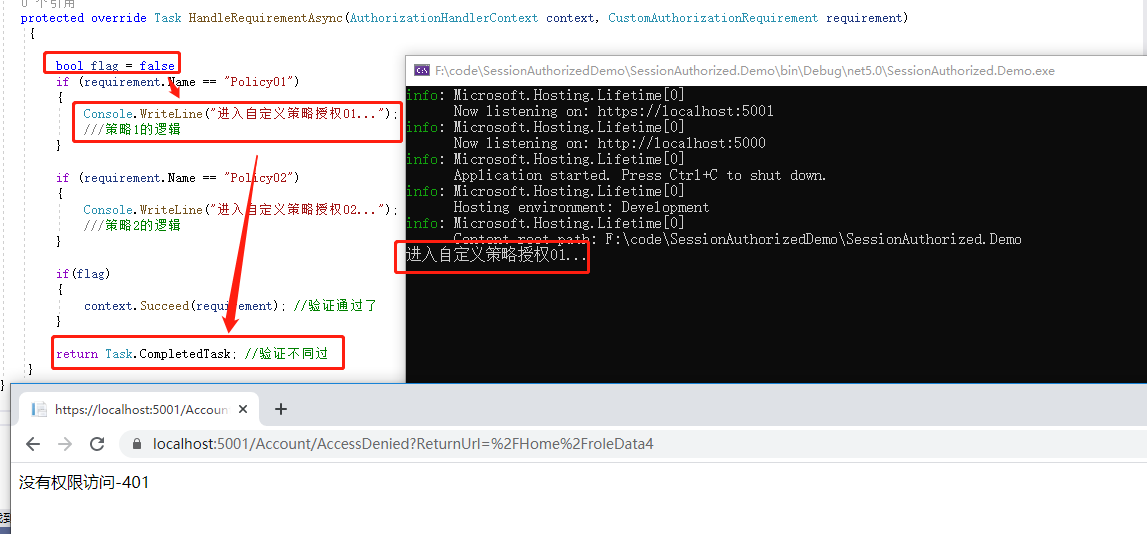
You can see that the user-defined authorization policy has taken effect, and the authorization policy can be done here. The authorization logic is added below.
The permissions here are associated with authorization by path and role, plus the verification code after authorization logic.
/// <summary>
///Custom authorization policy
/// </summary>
public class CustomAuthorizationHandler : AuthorizationHandler<CustomAuthorizationRequirement>
{
public CustomAuthorizationHandler()
{
}
protected override Task HandleRequirementAsync(AuthorizationHandlerContext context, CustomAuthorizationRequirement requirement)
{
bool flag = false;
//Convert the context to httpConext to facilitate context retrieval
HttpContext httpContext = context.Resource as HttpContext;
string path = httpContext.Request.Path;//Current access path, for example: "/ Home/roleData4"
var user = httpContext.User;
//User id
string userId = user.FindFirst("id")?.Value;
if (userId == null)
{
//No login, end directly
return Task.CompletedTask;
}
//When the login is successful, the url addresses in the menu permissions of all roles of the user are found according to the role and saved to redis. Here, the url address is actually found from redis according to the user id.
List<string> paths = new List<string>()
{
"/Home/roleData4",
"/Home/roleData3"
};
if (requirement.Name == "Policy01")
{
Console.WriteLine("Enter custom policy authorization 01...");
///Logic of strategy 1
if (paths.Contains(path))
{
flag = true;
}
}
if (requirement.Name == "Policy02")
{
Console.WriteLine("Enter custom policy authorization 02...");
///Logic of strategy 2
}
if (flag)
{
context.Succeed(requirement); //Verification passed
}
return Task.CompletedTask; //Verified different
}
}
Add logic before accessing.

The access is successful, and the custom authorization policy is completed.
Source code: https://github.com/weixiaolong325/SessionAuthorized.Demo
turn https://www.cnblogs.com/wei325/p/15575141.html